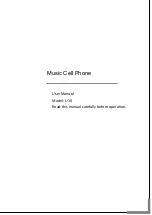
cancers when they were exposed to RF energy
compared to controls. There is much
uncertainty among scientists about whether
results obtained from animal studies apply to
the use of mobile phones. First, it is uncertain
how to apply the results obtained in rats and
mice to humans. Second, many of the studies
showed increased tumor development used
animals that had already been treated with
cancer-causing chemicals, and other studies
exposed the animals to the RF virtually
continuously — up to 22 hours per day.
For the past five years in the United States, the
mobile phone industry has supported research
into the safety of mobile phones. This
research has resulted in two findings in
particular that merit additional study:
1. In a hospital-based, case-control study,
researchers looked for an association between
mobile phone use and either glioma (a type of
brain cancer) or acoustic neuroma (a benign
tumor of the nerve sheath). No statistically
significant association was found between
mobile phone use and acoustic neuroma.
There was also no association between mobile
phone use and gliomas when all types of
gliomas were considered together. It should
be noted that the average length of mobile
phone exposure in this study was less than
three years.
When 20 types of glioma were considered
separately, however, an association was found
between mobile phone use and one rare type
of glioma, neuroepithelliomatous tumors. It is
possible with multiple comparisons of the
same sample that this association occurred by
chance. Moreover, the risk did not increase
with how often the mobile phone was used, or
the length of the calls. In fact, the risk actually
decreased with
cumulative hours of mobile phone use. Most
cancer causing agents increase risk with
increased exposure. An ongoing study of
brain cancers by the National Cancer Institute
is expected to bear on the accuracy and
repeatability of these results.
1
2. Researchers conducted a large battery of
laboratory tests to assess the effects of
exposure to mobile phone RF on genetic
material. These included tests for several
kinds of abnormalities, including mutations,
chromosomal aberrations, DNA strand breaks,
and structural changes in the genetic material
of blood cells called lymphocytes. None of
the tests showed any effect of the RF except
for the micronucleus assay, which detects
structural effects on the genetic material. The
cells in this assay showed changes after
exposure to simulated cell phone radiation,
but only after 24 hours of exposure. It is
possible that exposing the test cells to
radiation for this long resulted in heating.
Since this assay is known to be sensitive to
heating, heat alone could have caused the
abnormalities to occur. The data already in the
literature on the response of the micronucleus
assay to RF are conflicting. Thus follow-up
research is necessary.
2
FDA is currently working with government,
industry, and academic groups to ensure the
proper follow-up to these industry-funded
research findings. Collaboration with the
Cellular Telecommunications Industry
Association (CTIA) in particular is expected
to lead to FDA providing research
recommendations and scientific oversight of
new CTIA-funded research based on such
recommendations.
Two other studies of interest have been
reported recently in the literature:
U.S. FDA
Summary of Contents for SX56
Page 1: ......
Page 18: ...6 Appendix D Hardware Specifications 111 Appendix E Icons 112 Phone Icons 112 PDA Icons 112 ...
Page 137: ......
Page 138: ......









































